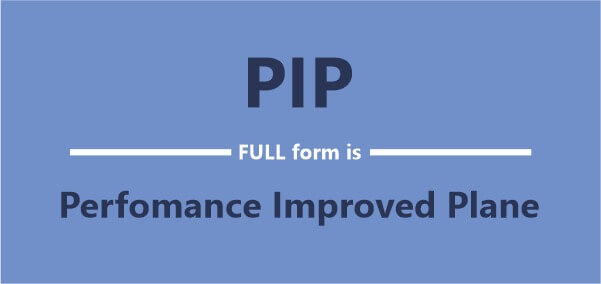What is the full form of PIPPIP: Performance Improvement PlanPIP stands for Performance Improvement Plan. It is a tool for evaluating a company's performance and developing strategies to increase efficiency. The performance improvement plan is the best method for updating and changing business procedures and patterns. Employers are given the chance to boost productivity by reorganising the format of improvement plans. 
As it identifies inadequacy, which results in a low range of performance, it is also known as a performance action plan. In order to create new plans, it is necessary to evaluate existing ones and make suggestions for upgrades. Plans for performance improvement go through five stages and have a number of benefits. Planning ahead for improvement reduces energy and resource waste. Stages of Performance Improvement Plan1. Look at the obstacleThe first step when a company begins to create the foundation for new improvement initiatives is to overcome obstacles. Making improved preparations is aided by being aware of the shortcomings or lack of prior plans. Examining the plan from the prior year and noting any dips in the plan is the simplest way to do this. The reasons for the bad performance change depending on the circumstance. Employees, technicalities, improper procedures, etc might occasionally be the cause. Studying potential points is just as crucial as researching where the strategy falls short. The helpful part makes recommendations for the procedures or techniques that produce the best results. 2. Include employee suggestionsEmployee participation in the creation of the new improvement plan is the second step. An employee made an attempt to maximise their benefits or efficacy. The employee deals with the issues or obstacles noted before, so their advice is crucial. Both the majority and minority's problems are kept track of. The best suggestions are discussed during a joint meeting and taken into account during the process of improvement. The feeling of being a part of the decision-making process and receiving equal treatment improves or raises the employee's morale. It encourages us to contribute our fullest abilities to the improvement. 3. Set realistic goalsSetting goals is the key phase of a performance development plan. The employer sets goals that are doable and reasonable for the workforce. To present a distinct image, they define it simply. A plan for achieving the goal without wasting time, effort, or resources can be created with the support of a clearly defined target. To preserve uniformity and prevent pressure, the goals are broken down into smaller, more manageable chunks. Every goal has a deadline to meet because it instils professionalism and a sense of urgency. Every aim is monitored by a specific objective manager who keeps a detailed and accurate record. Even minor details receive attention, and discipline is maintained. 4. Give staff trainingOne of the reasons the prior plan failed was a lack of employee expertise. Employee performance can be improved with the right training and management. The employer's new performance improvement plan makes achieving efficiency simply by giving employees new training and abilities. The manager ensures that the worker has the necessary tools and training to complete the assignment. Training and performance are improved by introduction and familiarity with the new environment. Training, assistance, and supervision increase one's capacity and expertise to produce the greatest results. Training can be formal or casual. 5. Monitoring and ExecutionBy following each phase, an employer creates a performance improvement plan to increase and expand effectiveness and efficiency. The final step in making the plan actionable is execution. The idea won't have an impact unless it has been adequately monitored. Daily records are required for efficient progress, and each objective must be completed by the designated deadline. It is simple to identify gaps in the plan when it is regularly monitored, and staff members can quickly fill them in by using workarounds. Plan execution and effective monitoring go hand in hand. It enables the employer to consider every aspect and come up with fair decisions as a result. Benefits of PIPThe following are benefits of creating a performance improvement plan:
ConclusionThe performance improvement plan's whole form is described in the above-mentioned article. When worse performances are noted, PIPs, or Performance Action Plans, are created to enhance, upgrade, and change. All of these things are accomplished by adhering to five-stage improvement plans, which comprise problem evaluation, peer discussion, objective formation, training, and implementation. Improvement is facilitated by group effort, engagement, a goal-oriented environment, and nature.
Next TopicFull Form
|
 For Videos Join Our Youtube Channel: Join Now
For Videos Join Our Youtube Channel: Join Now
Feedback
- Send your Feedback to [email protected]
Help Others, Please Share










